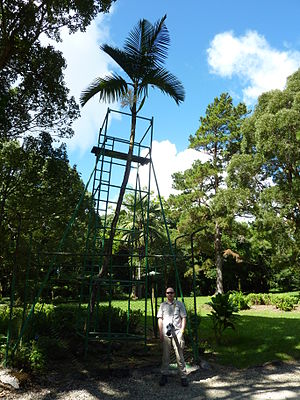Hyophorbe amaricaulis
| Hyophorbe amaricaulis | ||||||||||||
|---|---|---|---|---|---|---|---|---|---|---|---|---|

Flowering Hyophorbe amaricaulis in Curepipe |
||||||||||||
| Systematics | ||||||||||||
|
||||||||||||
| Scientific name | ||||||||||||
| Hyophorbe amaricaulis | ||||||||||||
| Mart. |
Hyophorbe amaricaulis ( Syn. : Mascarena revaughanii L.H.Bailey ) is an acute endangered species of the genus Hyophorbe in the family of Palm plants (Arecaceae).
distribution
The Hyophorbe amaricaulis is a pinnate palm species that is endemic to the island of Mauritius . In the Jardin Botanique de Curepipe located there, the last living specimen according to current knowledge grows.
description
The palm is about 12 meters high and has a relatively thin, gray trunk with a green, waxy, shimmering crown shaft. The crown has, typical for all five Hyophorbe species, only a few leaf fronds, each with 100–150 V-shaped pinnate leaves. The most striking difference to the related bottle palm ( Hyophorbe lagenicaulis ) and spindle palm ( Hyophorbe verschaffeltii ) is a uniformly thick, non-swollen trunk. From the other two related species, Hyophorbe indica and Hyophorbe vaughanii , it differs in the approaches of the leaf fronds, which arise from the crown shaft without gaps. The name of the palm refers to the fact that some Hyophorbe species have a bitter taste (Latin: amarus = bitter and caulis = trunk).
The inflorescences ( inflorescences ) grow below the crown shaft directly from the trunk upwards in a horn-shaped manner. The white to cream colored flowers of the male inflorescences open before the flowers of the female inflorescences, which prevents pollination. For this reason the seeds are sterile, which has made efforts to breed them unsuccessful for decades. Cloning from plant tissue led, without exception, to seedlings which died after removal from the sterile nutrient medium. Attempts have recently been made to pollinate female flowers with male pollen preserved in the cold; a success has not yet been reported.
Web links
- Hyophorbe amaricaulis inthe IUCN Red List of Threatened Species 2015.4. Posted by: Bachraz & Strahm, 2000. Retrieved February 7, 2016.
- http://www.pacsoa.org.au/palms/Hyophorbe/amaricaulis.html